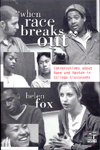So, did you all stay up to watch the Ontario election? Yeah, me neither. I suspect few people bothered to stay tuned to hear about the easily-predicted victory of Dalton McGuinty, who didn’t even have to break a sweat to win a second mandate with a majority government. His success is being largely attributed to opponent John Tory’s hugely unpopular position in favor of public funding for religious schools.
 |
| Grade Two students dribble during gym class at the Our Children Our Hope ISNA Elementary School in Mississauga, September 12, 2007. Photo credit: Steve Russell |
As a Quebecer who has been keeping track of the current debate on reasonable accommodation, I cannot help but opine that Ontario’s argument about funding faith-based schools is about more than government-subsidized religious instruction. I think the results speak to the heart of how Ontarians in particular, and Canadians in general, think a multicultural society should operate. And can you believe it? Turns out, we don’t really want to live in Trudeau’s cultural mosaic after all.
A recent SES poll finds that 53 percent of Canadians feel that immigrants should “fully adapt” to the Canadian way of life. In Quebec, 77 percent responded that immigrants should adapt to Quebec and Canadian society. Interestingly, support for reasonable accommodation is weakest in the provinces which are accepting the largest number of newcomers. A separate Léger Marketing poll done exclusively in Quebec shows the opposite trend – that is, support for reasonable accommodation is weakest in the eastern part of the province where people have less contact with minorities. The poll also found that younger Quebecers tend to be the most willing to accommodate religious minorities on certain issues.
From the Montreal Gazette, commenting on the poll:
Why the generation gap? Two reasons, said Sirma Bilge, an assistant professor of sociology at Université de Montréal who has studied the question.
“The younger generation has first-hand experience of diversity,” she said. “And they did not live through the Quiet Revolution. So they tend less to worship French-style secularism and feel less anxious about religious diversity and immigration.”
Young people are also more familiar with minorities in their daily lives - through personal contact, through the media and the Internet, through popular music and travel. Almost half of all 18-to-24-year-olds - 46 per cent - said they're often or occasionally in contact with Muslims, for example. That's three times more than the likelihood among over-65s, only 15 per cent of whom have contact.
“For the young generation, seeing a woman wearing the hijab is no big deal - it's part of the landscape, it's part of diversity,” said Patrice Brodeur, a Harvard-educated religion expert who teaches in Montreal. “And they're asking themselves ‘What's the big fuss?’”
This is exactly the question that I’ve been asking myself lately: What’s the big fuss? The news coverage of the Bouchard-Taylor Commission has left me reeling. Recently, the Quebec Council for the Status of Women has called for an outright ban on all “visible” religious symbols in public institutions (interestingly, the Council feels that a crucifix on a necklace is not “visible” enough to give offense, but hijabs, turbans and yarmulkes will have to go). This same group has called upon the government to amend the Quebec Charter so that women’s rights usurp religious freedoms, and Jean Charest seems amenable to the change.
Now, one could argue that Charest has little recourse but to pander to the worst - and most popular - side of the debate. Since the Hérouxville Manifesto of Intolerance and the ADQ’s sudden rise from obscurity, Charest has been trying to give his party a more nationalist flavor without alienating his Liberal base. Indeed, the appointment of the Bouchard-Taylor Commission can be seen, at worst, as a maneuver by Charest to pass the reasonable accommodation hot-potato during a precarious election season. But then again, perhaps a painfully frank discussion is what this province needs right now, and there can be absolutely no question that the discussion is frank.
What I’m wondering is if we are having the right discussions. Is the issue of frosted windows at the YMCA to accommodate orthodox Jews, or prayer spaces in public places to accommodate Muslims, or Sikh men wearing turbans while they work their RCMP beats really what’s got this province so upset? Are the citizens of Hérouxville really afraid that Muslim families are going to move in and start stoning their wives and daughters to death in the town square?
I suspect not. Goodness, I hope not. I think these issues are just the most visible and easily-sensationalized fronts of a much more abstract battle about values. The equality of men and women is a Canadian value. Democracy and free speech are Canadian values. Increasingly, people would like to consider secularism as a Canadian value as well, though this seems to be at odds with our proclaimed commitment to multiculturalism. We cannot pretend to be open to other cultures and then ask our Jewish doctors to remove their yarmulkes. It just doesn’t work that way.
But I think that in the majority of cases, it’s possible for us to find a way of accommodating religious minorities without compromising our values. What is needed is real leadership from our government, not constant political pandering to whichever side of the argument is biggest and loudest. We also must demand more responsible coverage from our news media, which is wont to sensationalize trivial conflicts in the interests of turning a profit. We need to have a serious discussion about the real issues – not about what people wear on their heads, but about what people believe in their hearts. We need to have an understanding of what the clothing truly signifies before we can make a judgment about whether or not these symbols threaten our way of life. We need to address the fears and misconceptions we have about social segregation and religious extremism before we can take fair and wise steps towards averting these threats to our social peace and national security. At last, we must have a definition of what multiculturalism truly means in Canada.
This conversation will happen in our media, in our communities – in our schools. As teachers, I think we will be in a privileged position to influence the dialogue, not by telling our students how we think the world should work, but by giving them an education they can use to form their own, informed opinions. This is why education is essential to democracy, to peace, and to liberty. And, this is one of the reasons I want to be a teacher.













2 comments:
Kristen,
You write thoughtfully, professionally and exceptionally. I am delighted to see that you are using this as a vehicle to launch these kinds of discussions.
L.
PS) Fantastic links!!
Post a Comment